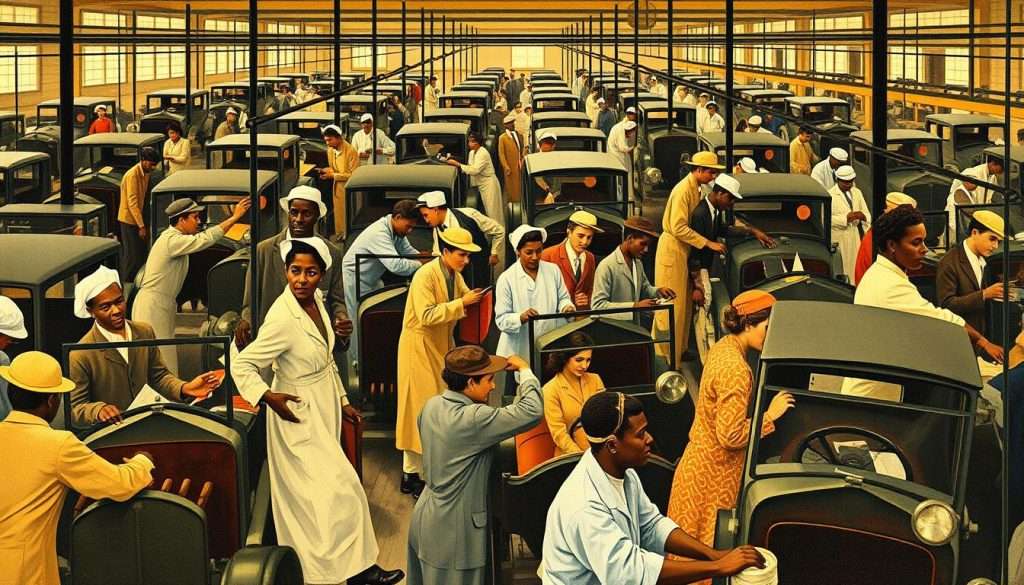Henry Ford’s work in Detroit was more than just making cars. It was a big part of the city’s cultural growth. How did Henry Ford affect diversity in Detroit? He started the Ford Motor Company in 1903, changing how cars were made.
This change brought jobs to many people. Detroit’s population grew fast, from 465,766 in 1910 to almost a million by 1920. The auto industry drew in many communities, especially during the Great Migration.
Ford’s fair wages helped break down racial barriers. This created a diverse and lively industrial workforce. His work changed Detroit’s economy, mixing different cultures and communities together.
The Early Days: Ford’s Arrival in Detroit
Henry Ford came to Detroit and changed everything. The car industry grew fast, and Ford’s ideas led the way. He brought new technology and a focus on diversity to the workforce.
Setting the Stage for Change
The Ford Motor Company started on June 16, 1903. The city was full of hope. The Model T came out in 1908, aiming to make cars for many people.
This car changed more than just how we travel. It also brought people from all walks of life to work. Ford wanted to create jobs and pay fair wages, starting a push for diversity in Detroit.
The Birth of the Ford Motor Company
In January 1914, Ford made a big announcement. They would pay workers $5.00 a day, double what most made. This move drew many men and women from different places to Detroit’s factories.
The company hired over 50 nationalities, showing Henry Ford’s commitment to diversity. The Ford English School helped everyone feel welcome and united. This showed Ford’s dedication to an inclusive workplace.
Ford also had a Sociological Department. They studied workers’ lives to help them. But, this also meant some workers were watched closely, which could affect their pay.
The Ford Motor Company’s start was key in creating a diverse workforce. This workforce helped the company grow and also changed Detroit for the better.
The Influence of the Assembly Line on Workforce Diversity
Henry Ford changed Detroit’s manufacturing with the assembly line. This move made production faster and helped create a more diverse workforce. Ford’s new way of making things needed many workers, including African Americans.
Innovations in Manufacturing
Ford’s assembly line made tasks simpler and work more efficient. People thought these jobs were easy, but they were key as demand grew. This new system brought more people into work, including those who were once left out.
Only 18% of auto workers were assemblers. This shows how complex and challenging auto jobs were. Many found it hard to get a job in this field.
Breaking Racial Barriers
Ford paid Black and white workers the same for the same job. This was a big change from the usual unfair practices. During World War I, more African Americans worked in auto plants.
This was a big step towards more diversity in Detroit. It helped break down old ethnic barriers. Skilled jobs that were once only for certain groups became open to more people.

| Factor | Details |
|---|---|
| Workforce Composition | 18% of auto workers were assemblers, with a majority in skilled roles. |
| Employment Demand | World War I created labor shortages, resulting in increased African American employment. |
| Pay Equality | Equal wages for Black and white workers in identical roles became a standard practice. |
| Ethnic Labor Division | Skilled positions often reserved for native-born Americans and European immigrants. |
| Long-Term Impact | By 1950, Detroit emerged with a significant Black middle class, reflecting changing demographics. |
The Great Migration and Ford’s Recruitment
The Great Migration changed Detroit’s people, making it a place for African Americans to find better lives. Henry Ford’s pay policies were key in drawing workers, especially African Americans.
The Attraction for African Americans
In the early 1900s, Ford’s $5 a day wage brought thousands from the South to Detroit. This was a big change, offering hope and safety from Jim Crow laws. Ford’s factories grew, changing Detroit’s diversity.
The number of African Americans in Detroit grew fast. Before World War I, they were just 1.2% of the population. By 1930, this number grew by over 1,991%.
Shifts in Detroit’s Demographics
Ford Motor Company changed Detroit’s people. By 1910, Detroit’s population grew from 285,000 to over 1.6 million by 1930. This migration brought new culture and diversity to the city.
By the 1910s, Ford led in hiring African American workers. This was a big step during a time of racism.
| Year | Population of Detroit | African American Population Change |
|---|---|---|
| 1900 | 285,000 | 1.2% |
| 1910 | 460,000 | Major influx begins |
| 1930 | 1,600,000 | 1,991% growth |
| 1950s | Close to 2 million | Peak population |
This change shows how Henry Ford helped Detroit become more diverse. African Americans played a big role in Detroit’s growth. For more, see Henry Ford’s impact on Detroit’s diversity.
Labor Relations and the Role of Unions
Henry Ford changed Detroit’s racial diversity in a big way. He did things differently than others in the early 1900s. Ford wanted to talk directly to his workers and their families, especially during the Great Migration.
His famous $5 a day wage in 1914 drew many workers. It gave African Americans, who often had few chances, a chance to succeed in factories.
Ford’s Approach to Labor
In the early 1900s, Ford stood out as a place of hope for many. He was one of the first to hire Black workers. By the 1920s, Ford had 45% of Black workers in the car industry.
The Black population in Detroit grew fast, from 41,000 in 1920 to 150,000 by 1930. Ford’s jobs, especially during World War I, helped many improve their lives.
Unions as a Catalyst for Diversity
Labor unions were key in making workplaces more diverse. They fought for fair treatment and helped hire more diverse workers. Unions helped workers from different races work together.
This unity helped Black workers speak up for their rights. It showed Ford’s effort to make work places more welcoming. Even with big challenges, Detroit’s work places started to reflect its diverse people.

Social Initiatives and Community Impact
Henry Ford worked hard to help Detroit. He wanted a better community. He focused on affordable homes and education, making Detroit a better place for everyone.
Affordable Housing and Its Ramifications
Ford knew good homes helped workers do better. His housing projects helped many families. This helped Detroit grow and become more diverse.
Education and Workforce Development
Ford started schools to help immigrant workers. He wanted them to do well in school and work. Henry Ford and diversity in Detroit grew through education and jobs.
Legacy and Continuing Influence on Diversity
Henry Ford’s legacy goes beyond the assembly line. It shapes how we think about diversity in Detroit today. Ford’s work in promoting diversity is clear in the company’s ongoing efforts to include everyone.
With a focus on helping underrepresented groups, Ford has made big investments. These include community outreach and new ways to build a diverse workforce. Detroit has grown a lot since Ford’s time, making big steps towards diversity.
The Modern Ford Company’s Diversity Efforts
Today, Ford Motor Company is keeping Henry Ford’s values alive. They have programs for minority-owned businesses, showing their commitment to diversity. Ford is helping to change Detroit by offering jobs and programs that celebrate its diversity.
Lasting Effects on Detroit’s Culture
Ford’s early work still affects Detroit’s culture today. The city’s streets and homes show the diversity Ford helped start. This diversity makes Detroit richer and more vibrant.
As Ford and Detroit’s stories blend, they show why diversity is key. It ensures a bright future for all generations.
